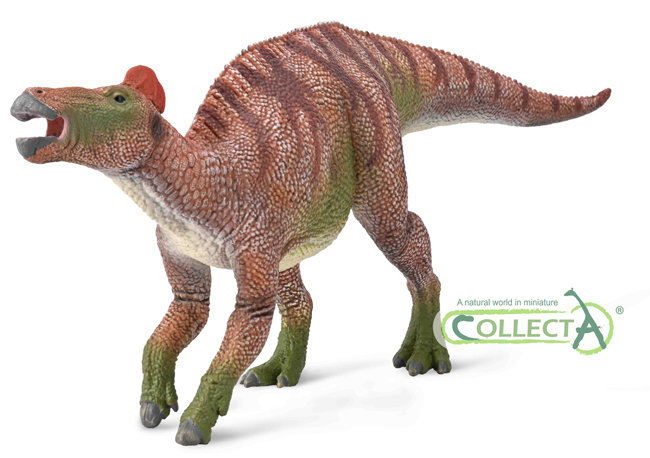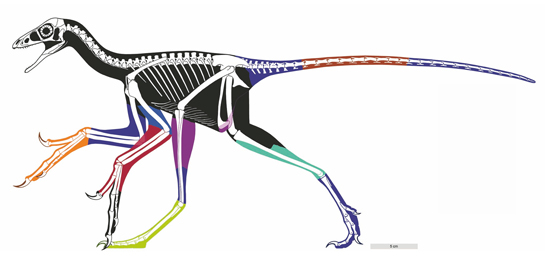A newly published scientific paper demonstrates that an Edmontosaurus fossil contains collagen. The study confirms fossils can retain original organic materials. The discovery of hydroxyproline, a unique collagen-indicator amino acid, in acid-digested samples resolves a long-standing debate amongst palaeontologists. Identifying organic materials in dinosaur bones could provide a new perspective on the Dinosauria.
Reports of proteins in fossilised bones have been a subject of controversy in the scientific literature. It is assumed that fossilisation results in the destruction of all organic components. However, this new research adds weight to the theory that in exceptional circumstances traces of organic materials can persist for tens of millions of years. Research led by scientists from the University of Liverpool suggests that Mesozoic fossils could still preserve remnants of original organic materials.

A view of the inside of the Edmontosaurus fossil bone. An exceptionally well-preserved Edmontosaurus sacrum excavated from the Upper Cretaceous strata of the South Dakota Hell Creek Formation is demonstrated to preserve evidence of hydroxyproline. Hydroxyproline is a unique collagen-indicator amino acid. Picture credit: University of Liverpool.
Picture credit: University of Liverpool
Edmontosaurus Fossil Contains Collagen
The research team used mass spectrometry and other advanced techniques to tease out traces of preserved collagen within the sacrum of an Edmontosaurus. Edmontosaurus is a duck-billed dinosaur (family Hadrosauridae). Fossils of these taxon come from Upper Cretaceous deposits of North America. It was a large, herbivorous dinosaur. Some specimens indicate a body length in excess of thirteen metres.

The CollectA Deluxe 1:40 scale Edmontosaurus dinosaur model. A detailed analysis of Edmontosaurus hip bone fossils (sacrum) reveals evidence of collagen.
The picture (above) shows a model of Edmontosaurus. This figure is from the CollectA Deluxe series.
To view the range of CollectA Deluxe prehistoric animal models: CollectA Deluxe Prehistoric Animal Figures.
Writing in the journal “Analytical Chemistry” the researchers outline several techniques, including protein sequencing that led to the detection of collagen in the fossilised bone. The specimen (a sacrum), was excavated from Hell Creek Formation deposits located in South Dakota. It is part of the University of Liverpool’s collections and offered a unique opportunity for cutting-edge analyses.
The Implications of this Research
Commenting on the significance of this study, co-author Professor Steve Taylor (chair of the Mass Spectrometry Research Group at the University of Liverpool), stated:
“This research shows beyond doubt that organic biomolecules, such as proteins like collagen, appear to be present in some fossils. Our results have far-reaching implications. Firstly, it refutes the hypothesis that any organics found in fossils must result from contamination. Secondly, it suggests that cross-polarised light microscopy images of fossil bones, collected for a century, should be revisited. These images may reveal intact patches of bone collagen, potentially offering a ready-made trove of fossil candidates for further protein analysis. This could unlock new insights into dinosaurs. For example, revealing connections between dinosaur species that remain unknown. Lastly, the findings inform the intriguing mystery of how these proteins have managed to persist in fossils for so long.”
Researchers from the University of California were also involved in this study. Mass spectrometry was used to detect and quantify, for the first time, the amino acid hydroxyproline, which is specific to collagen when found in bone, thus confirming the presence of decayed collagen.
Picture credit: University of Liverpool
The researchers conclude that their study demonstrated the presence of identical collagen peptide sequences previously discovered in another hadrosaur and a T. rex sample.
Links to Other Blog Posts
To read an article from 2017 about a study that identified fragments of collagen in the femur of a hadrosaur (Brachylophosaurus):Researchers Confirm the Presence of Dinosaur Collagen.
Traces of organic material discovered in a juvenile hadrosaur fossil: Has Dinosaur DNA Been Found?
Research from 2008 outlining the search for organic materials in a femur of Tyrannosaurus rex: Are You Going to Call the “Tyrant Lizard King” Chicken?
This newly published research opens further avenues for studying ancient life, offering a glimpse into the biochemical preservation of fossils of extinct creatures.
Everything Dinosaur acknowledges the assistance of a media release from the University of Liverpool in the compilation of this article.
The scientific paper: “Evidence for Endogenous Collagen in Edmontosaurus Fossil Bone” by Lucien Tuinstra, Brian Thomas, Steven Robinson, Krzysztof Pawlak, Gazmend Elezi, Kym Francis Faull, and Stephen Taylor published in Analytical Chemistry.
The award-winning Everything Dinosaur website: Dinosaur Toys and Models.





Leave A Comment